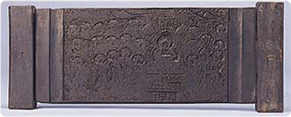Wooden boards were widely used for publishing books.Wooden boards kept in a temple were specially inscribed boards for Buddhism scriptures, called as
"Gyeongpan", "Gakpan", "Ganpan", "Chaekpan", "Jopan", "Nupan", and "Panmok".

"Wooden boards" were used in broad meanings-boards
bearing inscriptions of Buddhism scriptures, poems of monks, literature, or documentary archives.
Publishing Buddhism scriptures of Seonam-sa was bloomed between 17th century and 18th century. Until now, 840 boards in 28 kinds are left.
As Buddhism scripture, Wongakgyeong-mokpan made in 1655 and Beophwagyeong-mokpan made in 1660. Especially, wooden boards of Beophwagyeong-byeonsangdo contain
Samsehubul-do and the record of inscription saying Jihwan and Iluk made the boards.
As boards of literature, the collections of Chimgweng and Sangwol are left.
Tablets are frames made of wood, silk, or paper, hung over the door to display the name of buildings.
 Usually, tablets were hung horizontally - they were also called as
"Horizontal frames".
Seonam-sa Sungbo Museum possesses 86 tablets - tablets of autographs of King Sunjo, Gyeongsojeseonu which is the will of Chimgweng Monk, portraits of Gyeongun,
Hammyeong, and Sangwol Monks, and autographs of Chusa, Lee Samman, Shin and Gwanho are the main collections. Usually, tablets were hung horizontally - they were also called as
"Horizontal frames".
Seonam-sa Sungbo Museum possesses 86 tablets - tablets of autographs of King Sunjo, Gyeongsojeseonu which is the will of Chimgweng Monk, portraits of Gyeongun,
Hammyeong, and Sangwol Monks, and autographs of Chusa, Lee Samman, Shin and Gwanho are the main collections.
|
